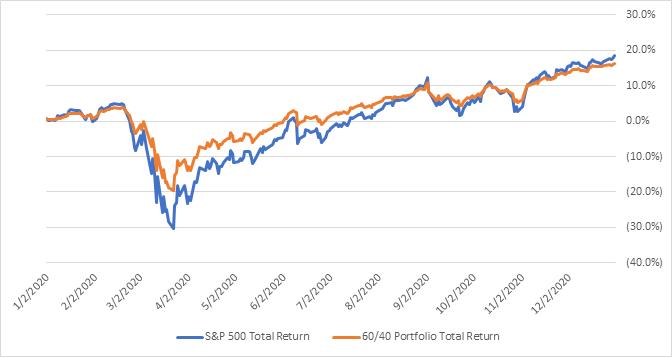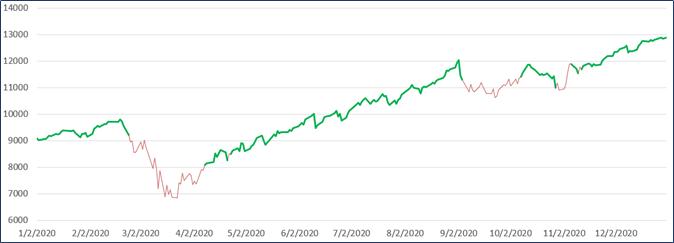With another year in the books, we think it is a good time to provide an update on our rules-based trend following strategies, and why we think they are a better approach to investing. Let's start with a 2020 market recap.
A passive buy & hold investor in the S&P 500 saw their account grow 18.4% in 2020, while an investor with a traditional 60/40 allocation saw a 16.26% return.

Must have been a great year for all investors, right? Not so fast. As we know, the annual return numbers never tell the whole story about the type of year investors had. The annual return is just the final outcome and shows nothing about how difficult either strategy was to stick with during the year. Nor does it reflect the investor anxiety felt during the year with the crazy news flow we are inundated with every day. It seems like in 2020, every news story that broke came with fear that markets would react poorly and sell off again. Would be great if we could just "blink" and have the annual returns locked in, but for better or for worse, we have to live through the day-to-day results of investing...and the market action in 2020 definitely supported the adage that "the days are long but the year is short!"
At its worst point, the S&P 500 was in a drawdown of 33.8% and the 60/40 portfolio was down 22.8%. Talk about some long days!

No one on that date (March 23rd) knew that the selling was over or that we were on our way to new all-time highs. Many expected the selling to continue, and even after the rebound started, investors were constantly scared of a bear trap where the market would reverse again and take another leg lower, as it has during many previous bear markets.
This didn't happen though, and it seems like the market rarely does what people expect. The passive S&P 500 investor had to ride the market down almost 34% and continue to stick with their investment plan in order to rebound and achieve the full 18.4% for the year. That is not a ride we could have handled with our serious investment accounts (retirement and long-term savings), and we're certain many other investors couldn't either. There are always those that intend to stick with a buy & hold approach but can't stomach the devastating losses of bear markets, which causes them to sell on the way down to stop the pain. They are then left trying to figure out when to re-allocate to equity markets or miss any chance of growth in their accounts. A 100% fixed income allocation probably doesn't cut it for most.
Trend following, that focuses on reducing drawdowns while still attempting to participate in market upside, typically provides a much smoother ride for investors. It doesn't require always guessing about what the market is going to do, rather it reads what the market is actually doing and acts accordingly. We always have a plan to get out of the market at predefined points during selloffs, and to reallocate to the market when a new uptrend is detected. Sometimes it works beautifully (like it did in 2020) and sometimes there will be whipsaw trades – accepting that fact, and sticking with it (discipline!), is the way to achieve the long-term benefits of the approach.
Below is a chart of the Nasdaq Composite showing when we were invested (green) versus defensive (red).

Our trend following model achieved positive returns each month from January 2020 through August 2020. We successfully avoided the bear market and were able to get back invested in April to participate in the rebound. We got stopped out in early September and moved defensive, then had a whipsaw trade in both October and November, before getting fully allocated mid-November through the end of the year.
All of that resulted in being up 35.8% net of fees on the year in the main trend strategy.
Dance with the Trend,
Greg Morris






